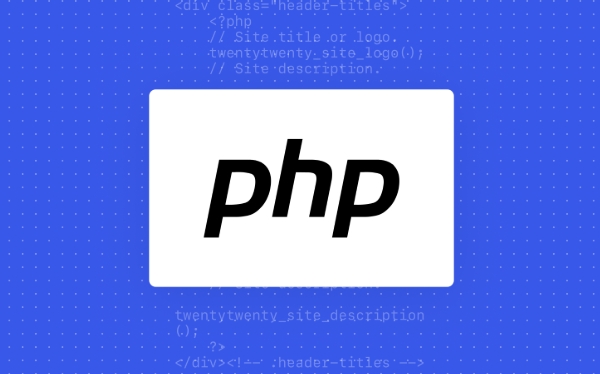 Backend Development
Backend Development
 PHP Tutorial
PHP Tutorial
 Navigating Proxies: Finding the Real User IP Address in $_SERVER
Navigating Proxies: Finding the Real User IP Address in $_SERVER
Navigating Proxies: Finding the Real User IP Address in $_SERVER
Aug 02, 2025 pm 04:05 PMTo find the real user IP address in $_SERVER when proxies are involved, check trusted proxy headers like HTTP_CF_CONNECTING_IP, HTTP_X_REAL_IP, and HTTP_X_FORWARDED_FOR in order of preference. 2. Validate the IP format and ensure it is not from private or reserved ranges using filter_var with FILTER_VALIDATE_IP, FILTER_FLAG_NO_PRIV_RANGE, and FILTER_FLAG_NO_RES_LEN. 3. Only trust these headers if the request passes through a known and trusted proxy or CDN, as they can be spoofed. 4. Extract the leftmost IP from HTTP_X_FORWARDED_FOR if present, as it typically represents the original client. 5. Fall back to $_SERVER['REMOTE_ADDR'] if no valid proxy header is found. 6. Implement logging and monitoring for unexpected IP values and maintain a whitelist of trusted proxy IPs for added security. By following these steps, you can reliably determine the original client IP in a secure and accurate manner.

When working with PHP applications behind proxies or load balancers, accurately identifying the real user IP address can be tricky. The $_SERVER superglobal usually contains client and server information, but when traffic passes through intermediaries like reverse proxies or CDNs, the value of $_SERVER['REMOTE_ADDR'] may reflect the proxy’s IP instead of the original user.

So how do you find the real user IP address in $_SERVER when proxies are involved?
Understand the Common Proxy Headers
Proxies and load balancers often pass the original client IP through special HTTP headers. The most common ones are:

-
HTTP_X_FORWARDED_FOR– A list of IP addresses indicating the chain of proxies the request passed through. The leftmost IP is typically the original client. -
HTTP_X_REAL_IP– Often used by reverse proxies like Nginx to pass the original client IP. -
HTTP_X_FORWARDED_HOSTandHTTP_X_FORWARDED_PROTO– Not for IP detection, but often used in proxy setups. -
HTTP_CF_CONNECTING_IP– Used by Cloudflare. -
HTTP_TRUE_CLIENT_IP– Also used by Cloudflare in certain configurations.
These are accessible in PHP via $_SERVER keys (with HTTP_ prefix and uppercase, replacing hyphens with underscores).
Validate and Prioritize Trusted Headers
You should never blindly trust these headers, as they can be spoofed by malicious clients. Only rely on them if you're certain the request came through a trusted proxy (e.g., your own load balancer or CDN).

Here’s a practical approach:
function getUserIP() {
// List of possible headers to check, in order of preference
$headers = [
'HTTP_CF_CONNECTING_IP', // Cloudflare
'HTTP_X_REAL_IP', // Nginx or custom proxy
'HTTP_X_FORWARDED_FOR', // Most common proxy header
];
foreach ($headers as $header) {
if (!empty($_SERVER[$header])) {
// Handle comma-separated list (common in X-Forwarded-For)
$ips = array_map('trim', explode(',', $_SERVER[$header]));
$ip = $ips[0]; // Take the leftmost IP (original client)
// Validate IP format and ensure it's not private/reserved
if (filter_var($ip, FILTER_VALIDATE_IP, FILTER_FLAG_NO_PRIV_RANGE | FILTER_FLAG_NO_RES_LEN)) {
return $ip;
}
}
}
// Fallback to REMOTE_ADDR if no valid proxy header found
return $_SERVER['REMOTE_ADDR'] ?? 'unknown';
}Key Considerations
-
Security: Only trust proxy headers if your server is behind a known proxy. If clients can bypass the proxy, they could fake their IP by sending a forged
X-Forwarded-For. - Private IP Ranges: Avoid accepting IPs from private ranges (like 10.0.0.0/8, 172.16.0.0/12, 192.168.0.0/16) unless you're certain of your network setup.
-
Multiple Proxies: In
X-Forwarded-For, each proxy appends the IP. The full chain might look like:client, proxy1, proxy2. The first IP is the original client. - CDN-Specific Headers: If using Cloudflare, Fastly, or AWS ELB, check their documentation for the correct headers they inject.
Final Thoughts
Finding the real user IP in $_SERVER when proxies are involved requires checking specific headers and validating their content. Always prioritize security over convenience—never assume headers are trustworthy unless you control the proxy layer.
Use a whitelist of trusted proxies, validate IP formats, and log unexpected values for monitoring. With proper handling, you can reliably extract the original client IP without compromising your application.
Basically, it’s not just about reading $_SERVER; it’s about knowing which keys to trust—and when.
The above is the detailed content of Navigating Proxies: Finding the Real User IP Address in $_SERVER. For more information, please follow other related articles on the PHP Chinese website!

Hot AI Tools

Undress AI Tool
Undress images for free

Undresser.AI Undress
AI-powered app for creating realistic nude photos

AI Clothes Remover
Online AI tool for removing clothes from photos.

Clothoff.io
AI clothes remover

Video Face Swap
Swap faces in any video effortlessly with our completely free AI face swap tool!

Hot Article

Hot Tools

Notepad++7.3.1
Easy-to-use and free code editor

SublimeText3 Chinese version
Chinese version, very easy to use

Zend Studio 13.0.1
Powerful PHP integrated development environment

Dreamweaver CS6
Visual web development tools

SublimeText3 Mac version
God-level code editing software (SublimeText3)
 PHP Variable Scope Explained
Jul 17, 2025 am 04:16 AM
PHP Variable Scope Explained
Jul 17, 2025 am 04:16 AM
Common problems and solutions for PHP variable scope include: 1. The global variable cannot be accessed within the function, and it needs to be passed in using the global keyword or parameter; 2. The static variable is declared with static, and it is only initialized once and the value is maintained between multiple calls; 3. Hyperglobal variables such as $_GET and $_POST can be used directly in any scope, but you need to pay attention to safe filtering; 4. Anonymous functions need to introduce parent scope variables through the use keyword, and when modifying external variables, you need to pass a reference. Mastering these rules can help avoid errors and improve code stability.
 How to handle File Uploads securely in PHP?
Jul 08, 2025 am 02:37 AM
How to handle File Uploads securely in PHP?
Jul 08, 2025 am 02:37 AM
To safely handle PHP file uploads, you need to verify the source and type, control the file name and path, set server restrictions, and process media files twice. 1. Verify the upload source to prevent CSRF through token and detect the real MIME type through finfo_file using whitelist control; 2. Rename the file to a random string and determine the extension to store it in a non-Web directory according to the detection type; 3. PHP configuration limits the upload size and temporary directory Nginx/Apache prohibits access to the upload directory; 4. The GD library resaves the pictures to clear potential malicious data.
 Commenting Out Code in PHP
Jul 18, 2025 am 04:57 AM
Commenting Out Code in PHP
Jul 18, 2025 am 04:57 AM
There are three common methods for PHP comment code: 1. Use // or # to block one line of code, and it is recommended to use //; 2. Use /.../ to wrap code blocks with multiple lines, which cannot be nested but can be crossed; 3. Combination skills comments such as using /if(){}/ to control logic blocks, or to improve efficiency with editor shortcut keys, you should pay attention to closing symbols and avoid nesting when using them.
 How Do Generators Work in PHP?
Jul 11, 2025 am 03:12 AM
How Do Generators Work in PHP?
Jul 11, 2025 am 03:12 AM
AgeneratorinPHPisamemory-efficientwaytoiterateoverlargedatasetsbyyieldingvaluesoneatatimeinsteadofreturningthemallatonce.1.Generatorsusetheyieldkeywordtoproducevaluesondemand,reducingmemoryusage.2.Theyareusefulforhandlingbigloops,readinglargefiles,or
 Tips for Writing PHP Comments
Jul 18, 2025 am 04:51 AM
Tips for Writing PHP Comments
Jul 18, 2025 am 04:51 AM
The key to writing PHP comments is to clarify the purpose and specifications. Comments should explain "why" rather than "what was done", avoiding redundancy or too simplicity. 1. Use a unified format, such as docblock (/*/) for class and method descriptions to improve readability and tool compatibility; 2. Emphasize the reasons behind the logic, such as why JS jumps need to be output manually; 3. Add an overview description before complex code, describe the process in steps, and help understand the overall idea; 4. Use TODO and FIXME rationally to mark to-do items and problems to facilitate subsequent tracking and collaboration. Good annotations can reduce communication costs and improve code maintenance efficiency.
 Quick PHP Installation Tutorial
Jul 18, 2025 am 04:52 AM
Quick PHP Installation Tutorial
Jul 18, 2025 am 04:52 AM
ToinstallPHPquickly,useXAMPPonWindowsorHomebrewonmacOS.1.OnWindows,downloadandinstallXAMPP,selectcomponents,startApache,andplacefilesinhtdocs.2.Alternatively,manuallyinstallPHPfromphp.netandsetupaserverlikeApache.3.OnmacOS,installHomebrew,thenrun'bre
 How to access a character in a string by index in PHP
Jul 12, 2025 am 03:15 AM
How to access a character in a string by index in PHP
Jul 12, 2025 am 03:15 AM
In PHP, you can use square brackets or curly braces to obtain string specific index characters, but square brackets are recommended; the index starts from 0, and the access outside the range returns a null value and cannot be assigned a value; mb_substr is required to handle multi-byte characters. For example: $str="hello";echo$str[0]; output h; and Chinese characters such as mb_substr($str,1,1) need to obtain the correct result; in actual applications, the length of the string should be checked before looping, dynamic strings need to be verified for validity, and multilingual projects recommend using multi-byte security functions uniformly.
 Learning PHP: A Beginner's Guide
Jul 18, 2025 am 04:54 AM
Learning PHP: A Beginner's Guide
Jul 18, 2025 am 04:54 AM
TolearnPHPeffectively,startbysettingupalocalserverenvironmentusingtoolslikeXAMPPandacodeeditorlikeVSCode.1)InstallXAMPPforApache,MySQL,andPHP.2)Useacodeeditorforsyntaxsupport.3)TestyoursetupwithasimplePHPfile.Next,learnPHPbasicsincludingvariables,ech





